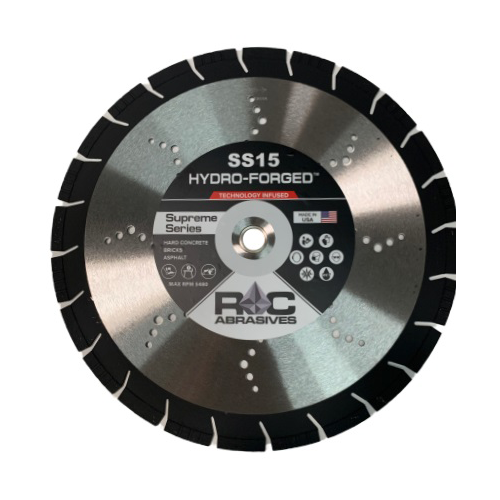Cause: Blade is used on a misaligned saw.
Remedy: Check for proper saw alignment.
Cause: Blade is excessively hard for the material being cut, creating stress on the steel center.
Remedy: Make certain that blade is correct for material being cut.
Cause: Utilizing blade flanges that are under size or not the same diameter, creating uneven pressure on center.
Remedy: Make certain that blade flanges are proper size and identical diameter.
Cause: Blade is used at improper RPM.
Remedy: Make certain blade shaft is turning at proper RPM by using a Tachometer -especially important with concrete saws.
Cause: Blade core is overheating from lack of side clearance due to uneven or too rapid segment wear.
Remedy: Specify a blade with a greater side clearance or a specification more suited to material being cut.
Cause: Segments worn on one side reducing side clearance, usually caused by misalignment of saw or lack of water on both sides of blade.
Remedy: Check saw alignment. Clean water system, making certain water is properly applied to leading edge of flanges.
Cause: Blade worn out of round due to bad bearings, worn arbor, missing bushing, arbor hole too large, or dirty flange surface.
Remedy: Replace bearings or worn arbor. Inspect flanges for damage and foreign materials. Do not remove drive pins with blade flanges.
TECHNICAL INFO


Loss of Alignment


Wearing Out Too Fast
Cause: Using wrong blade on highly abrasive material. (i.e. tile blade on concrete block.)
Remedy: Consult dealer or manufacturer for proper blade specification for abrasive material.
Cause: Blade not perpendicular to material being cut.
Remedy: Check blade shaft & flanges to ensure proper alignment of blade &equipment.
Cause: Blade shaft RPM too low.
Remedy: Check operating RPM of blade shaft and change equipment or blade shaft speed.
Broken Segments
Cause: Blade too hard for material being cut.
Remedy: Use a blade with a softer bond.


Cracked in The Core
Cause: Blade too hard for material being cut.
Remedy: Use correct blade with softer bond.
Cause: Excessive cutting pressure/or twisting blade in cut can cause blade core to bend and will cause core to eventually crack.
Remedy: Saw operator should use steady, even pressure, being careful not to twist or jam the blade in cut.
Cause: Overheating through inadequate water supply or improper use of dry cutting blades.
Remedy: Use adequate water to cool wet cutting diamond blades and allow airflow around dry cutting blades to prevent overheating.
Cause: RPM is too high.
Remedy: Check the operating RPM of the blade shaft.
Segment Loss
Cause: Material slips during cutting, twisting or jamming segments loose.
Remedy: Hold material securely while cutting
Cause: Blade is too hard for material being cut, causing dullness, which causes segment to pound off.
Remedy: Use a softer blade specification.
Cause: Out of round blade rotation results in pounding, caused by worn arbor or bad bearings in shaft.
Remedy: Replace worn arbor and/or bearings.
Cause: Overheating – Usually seen as bluish color on steel center, around area where segment was lost.
Remedy: Check water system for blocked passages. Test pump. For dry cuts make shallow cuts & let blade run free every few minutes to air cool
Cause: Segment is jolted while moving machine or contacting material being cut.
Remedy: Avoid jarring blade when moving machine. Contact material with slow, even movements.


Overheated Blade
Cause: Adequate coolant was not provided.
Remedy: Check water supply. Use dry blades only for shallow cutting/step cutting. Allow blade to run free every 10-15 seconds for cooling airflow.
Cause: Using improper specification for material being cut.
Remedy: Consult specification chart for proper blade.
Cause: Cutting speed is too fast.
Remedy: Reduce speed of advance.
Blade Won’t Cut
Cause: Blade is too hard for materials being cut. (i.e.: general purpose blade used on hard brick or asphalt blade used to cut hard concrete.)
Remedy: Consult dealer or manufacturer for proper blade to cut materials on job.
Cause: Blade has become dull because of continuous use on hard or vitrified material.
Remedy: Put blade into abrasive material until diamonds expose again. If happens often, blade is probably too hard for material.
Cause: Blade segments appear to have life, but blade will not cut.
Remedy: Some hard bond blades used for abrasive materials have a non-diamond section at base of segment to adhere to core. Replace blade.
Cause: Tool becomes glazed due to excessive RPM
Remedy: Match tool specification and diameter to the machine
Cause: Tool glazed due to inadequate pressure against material being cut
Remedy: Use proper pressure to keep blade sharpened, but avoid excess of pressure.


